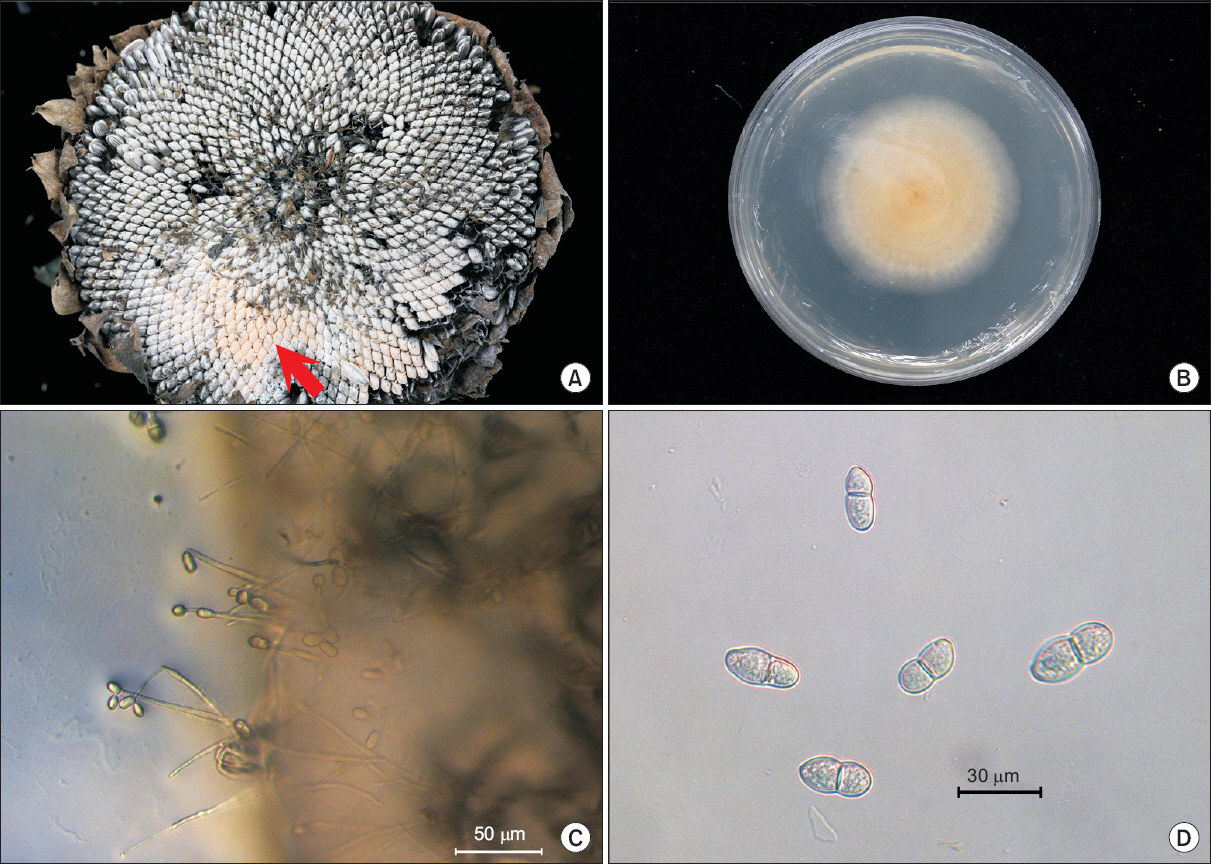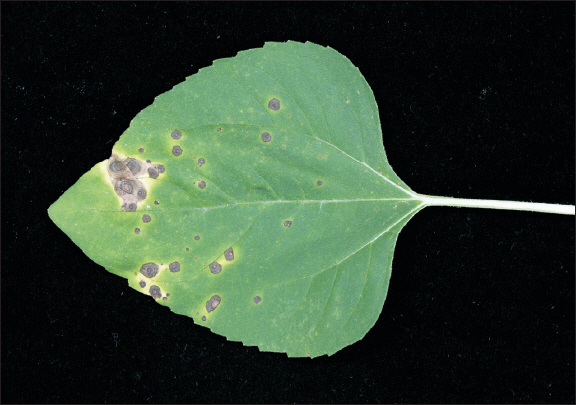ABSTRACT
Pink rot appeared in greenhouse-grown sunflower (Helianthus annuus L.) in Jeonju, Korea. The symptoms appeared as brown discoloration of sunflower head and progressed into stem in advanced stage. In order to investigate the causal organism of this disease, we isolated a fungus from the infected seeds and maintained the isolated fungal culture on potato dextrose agar medium. Conidiophores were simple or branched, 62.5 to 123.1 ╬╝m long. Conidia were produced in basipetal chains, ellipsoidal to pyriform with oblique and prominent truncate basal scars, two-celled, hyaline and measured 10.2-21.4├Ś7.5-12.6 ╬╝m. The fungus was inoculated to a new sunflower plant and showed the typical blight on the leaves. Study of morphological characters, pathogenicity tests and sequence analysis revealed that the isolated fungus is confirmed to be Trichothecium roseum. To our knowledge, this is the first report of pink rot on sunflower caused by T. roseum in Korea.
ņä£ļĪĀ
ĒĢ┤ļ░öļØ╝ĻĖ░(
Helianthus annuus L.)ļŖö ĻĄŁĒÖöĻ│╝(Asteraceae)ņØś 1ļģäņāØ ņ┤łļ│ĖņŗØļ¼╝ļĪ£ ļČüņĢäļ®öļ”¼ņ╣┤ ņżæņä£ļČĆ┬Ę ņ¦ĆņŚŁņØ┤ ņøÉņé░ņ¦ĆņØ┤ļŗż(
Heiser, 1951). ļĢģņĮ®, ņĮ®, ņ£Āņ▒ä ļō▒Ļ│╝ ļŹöļČłņ¢┤ 4ļīĆ ņ£Āņ¦Ćņ×æļ¼╝ ņżæņØś ĒĢśļéśļĪ£ ĒĢ┤ļ░öļØ╝ĻĖ░ņö©ņŚÉļŖö ņ¦Ćļ░®ņ£Ā, ĒĢäņłśņĢäļ»ĖļģĖņé░ņØ┤ ĒÆŹļČĆĒĢśņŚ¼ ĒśłņĢĪņł£ĒÖśņØä ļÅäņÖĆņŻ╝ļ®░ ļ╣äĒāĆļ»╝ ĒĢ©ļ¤ēņØ┤ ļ¦ÄņĢä ņśüņ¢æĒĢÖņĀüņ£╝ļĪ£ ņÜ░ņłśĒĢ£ ņŗØĒÆłņ£╝ļĪ£ ĻČīņןļÉ£ļŗż(
BaudetĻ│╝ Moss├®, 1977;
┼Ākori─ć ļō▒, 2008;
Warner, 2005).
ņäĖĻ│äņĀüņ£╝ļĪ£ ĒĢ┤ļ░öļØ╝ĻĖ░ņŚÉņä£ ļ░£ļ│æļÉśļŖö ņŻ╝ņÜö ļ│æņøÉņ£╝ļĪ£ļŖö ĒÆŗļ¦łļ”äļ│æ(
Ralstonia solanacearum), Ļ▓ĆņØĆļ¼┤ļŖ¼ļ│æ(
Alternaria spp.), ņ×┐ļ╣øĻ│░ĒīĪņØ┤ļ│æ(
Botrytis cinerea), ļģĖĻĘĀļ│æ(
Plasmopara spp.), ļģ╣ļ│æ(
Puccinia helianthi), ĻĘĀĒĢĄļ│æ(
Sclerotinia sclerotiorum), ņ×Äļ¦łļ”äļ│æ(
Septoria helianthi), ĒØ░Ļ░ĆļŻ©ļ│æ(
Sphaerotheca fusca) ļō▒ņØ┤ ņ׳ļŗż(
FarrĻ│╝ Rossman, 2016).
ĒĢ┤ļ░öļØ╝ĻĖ░ ņ×¼ļ░░ĒżņןņŚÉņä£ ĒĢ┤ļ░öļØ╝ĻĖ░ ĻĮā ļČĆļČäņØ┤ Ļ░ÉņŚ╝ņØ┤ ļÉśņ¢┤ ĒÖöļó░(head) ļČĆļČäņØ┤ Ļ░łļ│ĆļÉśņŚłņ£╝ļ®░ ņżäĻĖ░Ļ╣īņ¦Ć ĒŹ╝ņĀĖņä£ Ļ▓ĆĻ▓ī ļ│ĆĒĢśņśĆļŗż. ļ│æļōĀ ĒÖöļó░ņØś ņóģņ×ÉļĪ£ļČĆĒä░ ļ│æņøÉĻĘĀņØä ņł£ņłśļČäļ”¼ĒĢśņŚ¼ ĻĘĀņŻ╝ļź╝ ļČäļ”¼ĒĢśņśĆņ£╝ļ®░, ĒĢ┤ļ░öļØ╝ĻĖ░ņŚÉ ņØĖĻ│ĄņĀæņóģĒĢśņŚ¼ ļ│æņøÉņä▒ņØä ĒÖĢņØĖĒĢśņśĆļŗż. ļö░ļØ╝ņä£ ļ│Ė ņŚ░ĻĄ¼ļŖö ĒĢ┤ļ░öļØ╝ĻĖ░ņŚÉņä£ ņóģņ×ÉņØś ņŹ®ņØīļ│æņØä ņØ╝ņ£╝ĒéżļŖö ļ│æņØś ļ│æņ¦Ģ, ĻĘĀĒĢÖņĀü ĒŖ╣ņ¦Ģ, ļ│æņøÉņä▒ Ļ▓ĆņĀĢ ļ░Å ņŚ╝ĻĖ░ņä£ņŚ┤ ļČäņäØĻ▓░Ļ│╝ļź╝ ļ│┤Ļ│ĀĒĢśĻ│Āņ×É ĒĢ£ļŗż.
ļ░£ļ│æ ļ░Å ļ│æņ¦Ģ
2015ļģä 10ņøö ļåŹņŚģņ£ĀņĀäņ×ÉņøÉņä╝Ēä░ ĒĢ┤ļ░öļØ╝ĻĖ░ ņ×¼ļ░░ĒżņןņŚÉņä£ ĒĢ┤ļ░öļØ╝ĻĖ░ ĻĮā ļČĆļČäņØ┤ Ļ▓ĆĻ▓ī ļ│ĆĒĢśņŚ¼ ĒÖöļó░ ļČĆļČäņØ┤ Ļ░ÉņŚ╝ļÉśĻ│Ā ņżäĻĖ░Ļ╣īņ¦Ć Ļ▓ĆĻ▓ī ļ│ĆĒĢśņśĆļŗż. ņóģņ×ÉņØś Ļ▓ĮņÜ░ļŖö ņä▒ņłÖĒĢśņ¦Ć ļ¬╗ĒĢśņśĆĻ│Ā ņŗ¼ĒĢ£ Ļ▓ĮņÜ░ ņóģņ×ÉĻ░Ć ĻĘĀņé¼ņŚÉ ļŹ«ņśĆņ£╝ļ®░, ļČäĒÖŹņāēņØś Ēżņ×ÉņĖĄņØ┤ ĒśĢņä▒ļÉśĻĖ░ļÅä Ē¢łļŗż(
Fig. 1A). ļ│æņØ┤ ņ¦äņĀäļÉ©ņŚÉ ļö░ļØ╝ ņżäĻĖ░Ļ░Ć Ļ▓ĆĻ▓ī ļ│ĆĒĢśņŚ¼ Ļ│Āņé¼ĒĢśņśĆņ£╝ļ®░, ņóģņ×ÉļŖö ņŚ¼ļ¼╝ņ¦Ć ļ¬╗ĒĢśĻ│Ā ņŁēņĀĢņØ┤ļĪ£ ļé©Ļ▒░ļéś ĒāłļØĮĒĢśņśĆļŗż. ņØ┤ļ¤¼ĒĢ£ ņ”ØņāüņØĆ Ēżņן ļé┤ņŚÉņä£ ņŚ¼ļ¤¼ Ļ││ņŚÉ ņé░ļ░£ņĀüņ£╝ļĪ£ ļéśĒāĆļé¼ļŗż.
Fig.┬Ā1
Symptoms of pink rot on sunflower and microscopic investigation of causal organism. (A) Arrow indicates fungal mass in sunflower head. (B) Colony of isolated fungus on potato dextrose agar (PDA) media at 6 days after inoculation at 25┬░C. (C) Conidiophores and spores isolated fungus on PDA media. (D) Spores of isolated fungus on PDA media.

ļ│æņøÉĻĘĀņØś ļČäļ”¼
ĒżņןņŚÉņä£ ļ│æļōĀ ņŗØļ¼╝ņ▓┤ļź╝ ņłśņ¦æĒĢśņŚ¼ ļ│æņøÉĻĘĀņØä ņł£ņłśļČäļ”¼ ļ░░ņ¢æĒĢ£ Ēøä ĻĘĀĒĢÖņĀü ĒŖ╣ņä▒Ļ│╝ ļ│æņøÉņä▒ Ļ▓ĆņĀĢņØä ĒĢśņśĆļŗż. ļ│æņøÉĻĘĀņØä ļČäļ”¼ĒĢśĻĖ░ ņ£äĒĢ┤ Ļ░ÉņŚ╝ļÉ£ ĒÖöļó░ ļČĆļČäņØś ņóģņ×Éļź╝ 70% ņŚÉĒāäņś¼Ļ│╝ 1% NaOCl ņÜ®ņĢĪņŚÉņä£ 30ņ┤łĻ░ä Ēæ£ļ®┤ņé┤ĻĘĀĒĢśĻ│Ā ļ®ĖĻĘĀņłśļĪ£ 2ĒÜī ņäĖņ▓Ö Ēøä ļ®ĖĻĘĀļÉ£ ņŚ¼Ļ│╝ņ¦ĆņŚÉņä£ ļ¼╝ĻĖ░ļź╝ ņĀ£Ļ▒░ Ēøä ļ¼╝ĒĢ£ņ▓£ļ░░ņ¦Ć(water agar)ņŚÉ ņ╣śņāüĒĢśņśĆļŗż. 25┬░C ĒĢŁņś©ĻĖ░ņŚÉņä£ 3ņØ╝Ļ░ä ļ░░ņ¢æĒĢ£ ļÆż ĻĘĀņé¼ņ▓┤ ņäĀļŗ©ļČĆļź╝ ļ¢╝ņ¢┤ Ļ░Éņ×ÉĒĢ£ņ▓£ļ░░ņ¦Ć(Difco, Sparks, MD, USA)ņŚÉ ņś«Ļ▓© 25┬░CņŚÉņä£ ļ░░ņ¢æĒĢśņśĆļŗż. ļ░░ņ¦ĆņŚÉņä£ ĒśĢņä▒ļÉ£ Ēżņ×ÉļĪ£ļČĆĒä░ ļŗ©Ēżņ×ÉļČäļ”¼ļź╝ ņłśĒ¢ēĒĢ£ ļÆż ļ░░ņ¢æĒĢśņŚ¼ Ēżņ×Éļź╝ ĒśĢņä▒ņŗ£ņ╝░ļŗż. ĻĘĀņŻ╝ļ│┤Ļ┤ĆĻ│╝ ļ│æņøÉņä▒ Ļ▓ĆņĀĢņØä ņ£äĒĢ┤ ĒśĢņä▒ļÉ£ Ēżņ×Éļź╝ ņłśĻ▒░ĒĢśņŚ¼ 20% glycerolņŚÉ ļäŻĻ│Ā -70┬░C ņ┤łņĀĆņś©ņĀĆņןĻ│ĀņŚÉ ļ│┤Ļ┤ĆĒĢśņśĆņ£╝ļ®░, ļ│æņøÉņä▒ Ļ▓ĆņĀĢ ļ░Å ņŚ╝ĻĖ░ņä£ņŚ┤ ļČäņäØņŚÉ ņé¼ņÜ®ĒĢśņśĆļŗż.
ļ│æņøÉĻĘĀņØś ĻĘĀĒĢÖņĀü ĒŖ╣ņä▒
ļČäļ”¼ļÉ£ ļ│æņøÉĻĘĀņØĆ Ļ░Éņ×ÉĒĢ£ņ▓£ļ░░ņ¦ĆņŚÉņä£ ĒØ░ņāēņØś ĻĘĀņ┤ØņØä ĒśĢņä▒ĒĢśļ®░ ņ×Éļ×Éņ£╝ļ®░, ņØ┤ĒøäņŚÉļŖö ņŻ╝ĒÖ®ņāēņØś ņøÉĒśĢ ņĮ£ļĪ£ļŗłļź╝ ĒśĢņä▒ĒĢśņśĆņ£╝ļ®░ ļÅÖņØ╝ĒĢ£ ņāēĻ╣öņØś ļČäņāØĒżņ×ÉļŹ®ņ¢┤ļ”¼ļź╝ Ļ┤Ćņ░░ĒĢĀ ņłś ņ׳ņŚłļŗż(
Fig. 1B). ConidiophoresļŖö 92.9 ╬╝m (62.5-123.1 ╬╝m)ļĪ£ ļŗ©ņł£ĒśĢ ļśÉļŖö ļČäņ¦ĆĒśĢņØ┤ņŚłļŗż(
Fig. 1C). ļČäņāØĒżņ×ÉļŖö ļ¼┤ņāēņØś Ļ▓®ļ¦ēņØ┤ ņŚåĻ▒░ļéś ĒĢśļéś ņ׳ļŖö ļæźĻĘ╝ĒāĆņøÉĒśĢ Ēś╣ņØĆ ņä£ņ¢æļ░░ ļ¬©ņ¢æņ£╝ļĪ£ Ēü¼ĻĖ░ļŖö 10.2-21.4-7.5-12.6 ╬╝m (ĒÅēĻĘĀ 16.3-9.7 Ēāå)ņśĆļŗż(
Fig. 1D). ĒĢ┤ļ░öļØ╝ĻĖ░ņŚÉņä£ ļČäļ”¼ĒĢ£ ļ│æņøÉĻĘĀ S068ņØĆ ĻĖ░ņĪ┤ņŚÉ ņĢīļĀżņ¦ä
Trichothecium roseumĻ│╝ ĒśĢĒā£ņĀüņ£╝ļĪ£ ņ£Āņé¼ĒĢśņśĆļŗż(
Table 1) (
Oh ļō▒, 2014).
Table┬Ā1
Morphological characteristics of Trichothecium roseum isolated from sunflower and other hosts
|
Structure |
Character |
S068 |
T. roseum*
|
|
Colony |
Color |
Pale roseae |
Pale roseae |
|
ConidiophoresŌĆā |
Shape |
Simple or branched belowŌĆā |
Simple or branched below |
|
Length (╬╝m) |
62.5-123.1 |
150-260 |
|
Conidia |
Shape |
Ellipsoidal, 2 cell |
Ellipsoidal, 2 cell |
|
Diameter (╬╝m)ŌĆā |
10.2-21.4├Ś7.5-12.6 |
18-22├Ś8-10 |
ļ│æņøÉņä▒ Ļ▓ĆņĀĢ
ļ│æņøÉņä▒ Ļ▓ĆņĀĢņØĆ Ēīīņóģ Ēøä 3ņŻ╝ļÉ£ ņ£Āļ¼śņŚÉņä£ ņŗżņŗ£ĒĢśņśĆļŗż. ļČäļ”¼ļÉ£ Ļ│░ĒīĪņØ┤ĻĘĀņØä Ļ░Éņ×ÉĒĢ£ņ▓£ļ░░ņ¦ĆņŚÉņä£ 7ņØ╝Ļ░ä ļ░░ņ¢æĒĢśņŚ¼ ļČäņāØĒżņ×Éļź╝ 1├Ś10
6 conidia/ml ļåŹļÅäļĪ£ ļ¦×ņČöņ¢┤ Ļ▒┤ņĀäĒĢ£ ĒĢ┤ļ░öļØ╝ĻĖ░ ņ£Āļ¼śņŚÉ 10 mlņö® ļČäļ¼┤ĻĖ░ļĪ£ ņé┤ĒżĒĢśņśĆņ£╝ļ®░, ĒĢśļŻ© ļÅÖņĢł Ļ│ĀņŖĄļÅäņāØņןņāüņŚÉņä£ ņĄ£Ļ│Ā ņŖĄļÅäļź╝ ņ£Āņ¦ĆĒĢ£ ļÆż ĻĘĖ Ēøä ņś©ņŗżņŚÉņä£ 20┬░C-25┬░C ņś©ļÅäļź╝ ņ£Āņ¦ĆĒĢśņśĆļŗż. ņĀæņóģ 9ņØ╝ Ēøä ņ×ÄņŚÉņä£ Ļ▓ĆņØĆņāēņØś ņ£żļ¼ĖĒśĢ ļ░śņĀÉņØ┤ ļéśĒāĆļé¼ņ£╝ļ®░(
Fig. 2), ņĀæņóģĒĢ£ ĻĘĀņŻ╝ņÖĆ ļÅÖņØ╝ĒĢ£ ĻĘĀņØ┤ ņ×¼ļČäļ”¼ļÉśņŚłļŗż. ļö░ļØ╝ņä£ ļČäļ”¼ĒĢ£ ļ│æņøÉĻĘĀņØĆ ņøÉņØĖļ│æņøÉĻĘĀņ£╝ļĪ£ ĒīÉļŗ©ļÉśņŚłņ£╝ļ®░ ļīĆņĪ░ĻĄ¼ņŚÉņä£ļŖö ļ│æņ¦ĢņØ┤ ļéśĒāĆļéśņ¦Ć ņĢŖņĢśļŗż.
Fig.┬Ā2
Typical symptoms were observed at 9 days after inoculation.

ņŚ╝ĻĖ░ņä£ņŚ┤ ļČäņäØ
ĒśĢĒā£ņĀüņØĖ ĒŖ╣ņä▒ņØä ļÆĘļ░øņ╣©ĒĢśĻĖ░ ņ£äĒĢ┤ ņŚ╝ĻĖ░ņä£ņŚ┤ ļČäņäØņØä ņŗżņŗ£ĒĢśņśĆļŗż. ļČäļ”¼ĒĢ£ ļ│æņøÉĻĘĀņØä Ļ░Éņ×ÉĒĢ£ņ▓£ļ░░ņ¦ĆņŚÉņä£ 1ņŻ╝ņØ╝Ļ░ä ļ░░ņ¢æ Ēøä ribosomal DNA (rDNA)ņØś internal transcribed spacer (ITS) ņśüņŚŁņØś ņŚ╝ĻĖ░ņä£ņŚ┤ņØä ļČäņäØĒĢśņśĆļŗż(
White ļō▒, 1990). Genomic DNAļŖö DNeasy Plant Mini Kit (Qiagen, Hilden, Germany)ļź╝ ņØ┤ņÜ®ĒĢśņŚ¼ ļČäļ”¼ĒĢśņśĆņ£╝ļ®░, ITS1/ITS4 primerļź╝ ņØ┤ņÜ®ĒĢśņŚ¼ PCR ņ”ØĒÅŁĒĢśņśĆļŗż(
White ļō▒, 1990). ņ”ØĒÅŁ ņé░ļ¼╝ņØĆ ņŚ╝ĻĖ░ņä£ņŚ┤ ļČäņäØņØä ĒĢśņŚ¼ GenBank database (
http://blast.ncbi.nlm.nih.gov/Blast.cgi)ņØś ļŹ░ņØ┤Ēä░ļ▓ĀņØ┤ņŖżļź╝ ņØ┤ņÜ®ĒĢśņŚ¼ ĒÖĢņØĖĒĢśņśĆļŗż. Ļ│äĒåĄņłś ļČäņäØņØĆ GenBank ļŹ░ņØ┤Ēä░ļ▓ĀņØ┤ņŖżņØś ITS ņŚ╝ĻĖ░ņä£ņŚ┤ļōżņØä ņØ┤ņÜ®ĒĢśņŚ¼ MEGA 6.0 ĒöäļĪ£ĻĘĖļשņØä ĒåĄĒĢ┤ neighbor-joining ļ░®ļ▓Ģņ£╝ļĪ£ phylogenetic ļČäņäØņØä ņłśĒ¢ēĒĢśņśĆļŗż. Sequence distanceļŖö Tajima-Nei parameter modelļĪ£ Ļ│äņé░ĒĢśņśĆļŗż(
SaitouņÖĆ Nei, 1987;
Tamura ļō▒, 2013). ĒĢ┤ļ░öļØ╝ĻĖ░ņŚÉņä£ ļČäļ”¼ĒĢ£ ļ│æņøÉĻĘĀ S068ņØś ITS ņŚ╝ĻĖ░ņä£ņŚ┤ņØś Ēü¼ĻĖ░ļŖö 582 bpļĪ£ GenBankņŚÉ ĻĖ░ĒāüĒĢśņśĆļŗż(accession no. KX768876). National Center for Biotechnology InformationņØś BLAST search Ļ▓░Ļ│╝
Trichothecium roseumļĪ£ ļō▒ļĪØļÉ£ GenBank accession nos. KP317992, KF897865, JX997437 ļō▒Ļ│╝ 100% ņØ╝ņ╣śĒĢśņśĆļŗż. Ļ│äĒåĄņłśņ×æņä▒ Ļ▓░Ļ│╝ KX768876ņØś ITS ņŚ╝ĻĖ░ņä£ņŚ┤ņØ┤
T. roseumĻ│╝ Ļ░ÖņØĆ Ļ│äĒåĄĻĄ░ņŚÉ ņåŹĒĢ©ņØä ĒÖĢņØĖĒĢĀ ņłś ņ׳ņŚłļŗż(
Fig. 3).
Fig.┬Ā3
Phylogenetic analysis of sequence of the internal transcribed spacer ribosomal DNA (rDNA) region of the Trichothecium roseum with closely related strains retrieved from GenBank. The tree was constructed based on the neighbor-joining method with 1,000 replicates. The numbers above the branches represent the bootstrap value. The fungus identified in this study is boldfaced.

T. roseumņŚÉ ņØśĒĢ£ ĒĢ┤ļ░öļØ╝ĻĖ░ ņłśĻ│╝ņŚÉņä£ņØś ļ│æņØĆ ņĪ░ņ¦ĆņĢä, ĒÅ┤ļ×Ćļō£ņŚÉņä£ ļ│┤Ļ│ĀļÉśņ¢┤ ņ׳ņ£╝ļéś(
FarrĻ│╝ Rossman, 2016) ņÜ░ļ”¼ļéśļØ╝ņŚÉļŖö ņĢäņ¦ü ļ│┤Ļ│ĀļÉśņ¦Ć ņĢŖņĢśļŗż(
The Korean Society of Plant Pathology, 2009). ļö░ļØ╝ņä£ ĒĢ┤ļ░öļØ╝ĻĖ░ ĒÖöļó░ņŚÉņä£ ņŹ®ņØīļ│æņØä ņØ╝ņ£╝ĒéżļŖö ĻĘĀņØä ļČäļ”¼ĒĢśņŚ¼ ĻĘĀĒĢÖņĀü ĒŖ╣ņä▒, ļ│æņøÉņä▒ Ļ▓ĆņĀĢ, ITS rDNA ņŚ╝ĻĖ░ņä£ņŚ┤ ļ╣äĻĄÉļČäņäØ ļō▒ņØś Ļ▓░Ļ│╝ļź╝ ļ░öĒāĢņ£╝ļĪ£
T. roseumņŚÉ ņØśĒĢ£ ĒĢ┤ļ░öļØ╝ĻĖ░ ļČäĒÖŹļ╣øņŹ®ņØīļ│æņØ┤ļØ╝ ļ¬ģļ¬ģĒĢśĻ│Āņ×É ĒĢ£ļŗż.
ņÜöņĢĮ
ĒĢ┤ļ░öļØ╝ĻĖ░ ņ×¼ļ░░ĒżņןņŚÉņä£ ĒÖöļó░ ļČĆļČäņØ┤ ņŹ®ļŖö ņ”ØņāüņØ┤ ļéśĒāĆļé¼ļŗż. ļ│æņ¦ĢņØĆ Ļ░ÉņŚ╝ļÉ£ ĒÖöļó░ ļČĆļČäņØ┤ Ļ░łļ│ĆļÉśņ¢┤ ņżäĻĖ░ļĪ£ ļ▓łņĀĖĻ░öļŗż. Ļ░ÉņŚ╝ļÉ£ ĒÖöļó░ņØś ņóģņ×ÉņŚÉļŖö ņŻ╝ĒÖ®ņāēņØś Ēżņ×ÉļŹ®ņ¢┤ļ”¼ļź╝ Ļ┤Ćņ░░ĒĢĀ ņłś ņ׳ņŚłļŗż. ļ│æņ¦Ģņ£╝ļĪ£ļČĆĒä░ Ļ│░ĒīĪņØ┤ļź╝ ņł£ņłś ļČäļ”¼ĒĢśņŚ¼ Ļ░Éņ×ÉĒĢ£ņ▓£ļ░░ņ¦ĆņŚÉ ļ░░ņ¢æĒĢ£ Ļ▓░Ļ│╝, conidiophoresņŚÉ Ēżņ×Éļź╝ ĒśĢņä▒ĒĢśņŚ¼ ĒØ░ņāēņŚÉņä£ ļČäĒÖŹļ╣øņØä ļØĀņŚłļŗż. ConidiophoresļŖö ļŗ©ņł£ĒśĢ ļśÉļŖö ļČäņ¦ĆĒśĢņ£╝ļĪ£ ĻĖĖņØ┤ļŖö 62.5-123.1 ĒāåņśĆļŗż. ļČäņāØĒżņ×ÉļŖö ļ¼┤ņāēņØś Ļ▓®ļ¦ēņØ┤ ņŚåĻ▒░ļéś ĒĢśļéś ņ׳ļŖö ļæźĻĘ╝ĒāĆņøÉĒśĢņŚÉņä£ ņä£ņ¢æļ░░ ļ¬©ņ¢æņ£╝ļĪ£ Ēü¼ĻĖ░ļŖö 10.2-21.4-7.5-12.6 ĒāåņśĆļŗż. ņØ┤ ĻĘĀņØĆ Ļ▒┤ņĀäĒĢ£ ĒĢ┤ļ░öļØ╝ĻĖ░ ņ×ÄņŚÉ ņĀæņóģĒĢśņśĆņØä ļĢī ņ×ÄņŚÉņä£ ņ£żļ¼ĖĒśĢņØś Ļ▓ĆņØĆņāē ļ░śņĀÉņØä ĒśĢņä▒ĒĢśņśĆļŗż. ĻĘĀĒĢÖņĀü ĒŖ╣ņ¦Ģ, ļ│æņøÉņä▒ Ļ▓ĆņĀĢ, ITS ņŚ╝ĻĖ░ņä£ņŚ┤ ļČäņäØ ļō▒ņØś Ļ▓░Ļ│╝ļź╝ ļ░öĒāĢņ£╝ļĪ£ Trichothecium roseumņ£╝ļĪ£ ļÅÖņĀĢļÉśņŚłņ£╝ļ®░ ĒĢ┤ļ░öļØ╝ĻĖ░ ļČäĒÖŹļ╣øņŹ®ņØīļ│æņ£╝ļĪ£ ļ¬ģļ¬ģĒĢśĻ│Āņ×É ĒĢ£ļŗż.
Acknowledgement
This study was supported by a grant (Project No. PJ01011801) funded by National Institute of Agricultural Sciences, Rural Development Administration, and by a 2016 Postdoctorial Fellowship Program of the National Institute of Agricultural Sciences, Rural Development Administration, Republic of Korea.
References
Baudet, J and Moss├®, J 1977. Fractionation of sunflower seed proteins.
J. Am. Oil Chem. Soc 54: A82

Farr, D. F and Rossman, A. Y (2016 onwards). Fungal Databases Systematic Mycology and Microbiology Laboratory ARS USDA. Version:1st June 2016. URL
http://nt.ars-grin.gov/fungaldatabases/[25 September 2016].
Heiser, C. B 1951. The sunflower among the North American Indians. Proc. Am. Philos. Soc 95: 432-448.
Oh, S. Y, Nam, K. W and Yoon, D. H 2014. Identification of
Acremonium acutatum and
Trichothecium roseum isolated from grape with white stain symptom in Korea.
Mycobiology 42: 269-273.



Saitou, N and Nei, M 1987. The neighbor-joining method: a new method for reconstructing phylogenetic trees.
Mol. Biol. Evol 4: 406-425.

┼Ākori─ć, D, Joci─ć, S, Saka─Ź, Z and Le─Źi─ć, N 2008. Genetic possibilities for altering sunflower oil quality to obtain novel oils.
Can. J. Physiol. Pharmacol 86: 215-221.


Tamura, K, Stecher, G, Peterson, D, Filipski, A and Kumar, S 2013. MEGA6: Molecular Evolutionary Genetics Analysis version 6.0.
Mol Biol Evol 30: 2725-2729.



The Korean Society of Plant Pathology. 2009. List of Plant Disease in Korea. 5th ed The Korean Society of Plant Pathology, Suwon, Korea. pp. 853.(In Korean)
Warner, K 2005. Effects on the flavor and oxidative stability of stripped soybean and sunflower oils with added pure tocopherols.
J. Agric. Food Chem 53: 9906-9910.


White, T. J, Bruns, T, Lee, S and Taylor, J. W 1990. Amplification and direct sequencing of fungal ribosomal RNA genes for phylogenetics.
In: PCR Protocols: A Guide to Methods and Applications M. A Innis, D. H Gelfand, J. J Sninsky and T. J White 315-322. Academic Press, New York, NY, USA







 PDF Links
PDF Links PubReader
PubReader Full text via DOI
Full text via DOI Download Citation
Download Citation Print
Print






